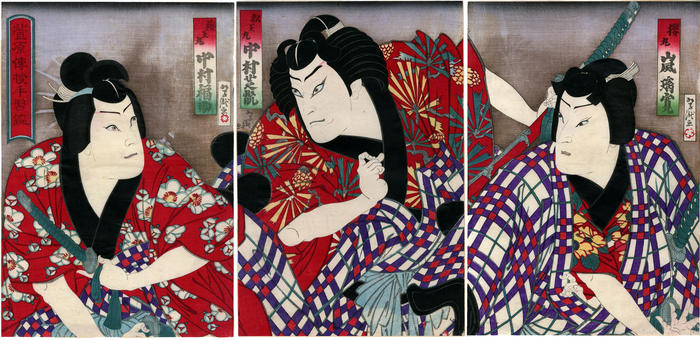Utagawa Yoshitaki (歌川芳滝) (artist 1841 – 1899)
Arashi Rikan IV (嵐璃寛) as Sakuramaru (桜丸), Nakamura Shikan IV (中村芝翫) as Matsuōmaru (松王丸) and Nakamura Fukusuke III (中村福助) as Umeōmaru (梅王丸) in the play Sugawara denju tenarai kagami (菅原伝授手習鑑)
1880
29.25 in x 14 in (Overall dimensions) Japanese color woodblock print
Signed: Yoshitaki ga (芳瀧画) Seals in red below the signatures
Waseda University - right panel Umeōmaru and his brother Sakuramaru are loyal followers of Sugawara Michizani. Their brother Matsuōmaru is opposed to them and represents the darker side of their family.
****
Clearly this was a deluxe printing. The use of metallic inks and special effects like the oxidized ashy-lavender background is astounding. Add the that the vibrancy of the controlled use of aniline dyes and this is truly one of the most eye-catching and spectacular items in the entire Lyon Collection.
While not totally unique in the Yoshitaki oeuvre, this triptych does stand out in both style and layout in the way the figures fill the space of each sheet. The rarity of the metallic looking background - the only other example we could find is from a diptych from 1872 - and we are left with one of the most unique compositions to be found anywhere by this artist. A truly special treasure. It has two of the finest qualities to be found in ukiyo-e: both freshness and rarity. (JSV)
****
Illustrated in color in Osaka Prints by Dean J. Schwaab, 1989, page 227, no. 248. Schwaab wrote: "As with Edo prints of the same period, the use of aniline colors, particularly as replacements for the sensitive red and purple, was well advanced by the beginning of the Meiji period in 1867. It is apparent that, as with natural pigments, aniline colors varied in quality; and the Ōsaka printers apparently continued to prefer to use a high quality on their deluxe printings. This is particularly true of the red, a color of such density that it leaves an impression of richness rather than tawdriness. As a result, though the change in palette is very apparent, it does not attain the degree of garishness deplored in most prints of this late era. In addition, Ōsaka printers continued to employ traditional high-quality printing techniques. These factors resulted in a product that was quite successful by the standards of the period. This triptych has lacquer applied to the black areas and a silver pigment on metal mounts; the figures are contrasted with a lavender pigment, which has oxidized to a charcoal color."
****
There is no publisher's seal. Perhaps, considering the deluxe nature of this triptych, it was printed privately. However, there are two different artist's seal found below the signatures on the right and left panel. We have yet to discover anything about these seals but will keep looking.
actor prints (yakusha-e - 役者絵) (genre)
Nakamura Shikan IV (四代目中村芝翫: 7/1860 to January 1899) (actor)
Kyōto-Osaka prints (kamigata-e - 上方絵) (genre)
Arashi Rikan IV (四代目嵐璃寛: from 8/1867 to 5/3/1894) (actor)
Nakamura Fukusuke III (三代目中村福助: from 03/1868 to 09/1907) (actor)
